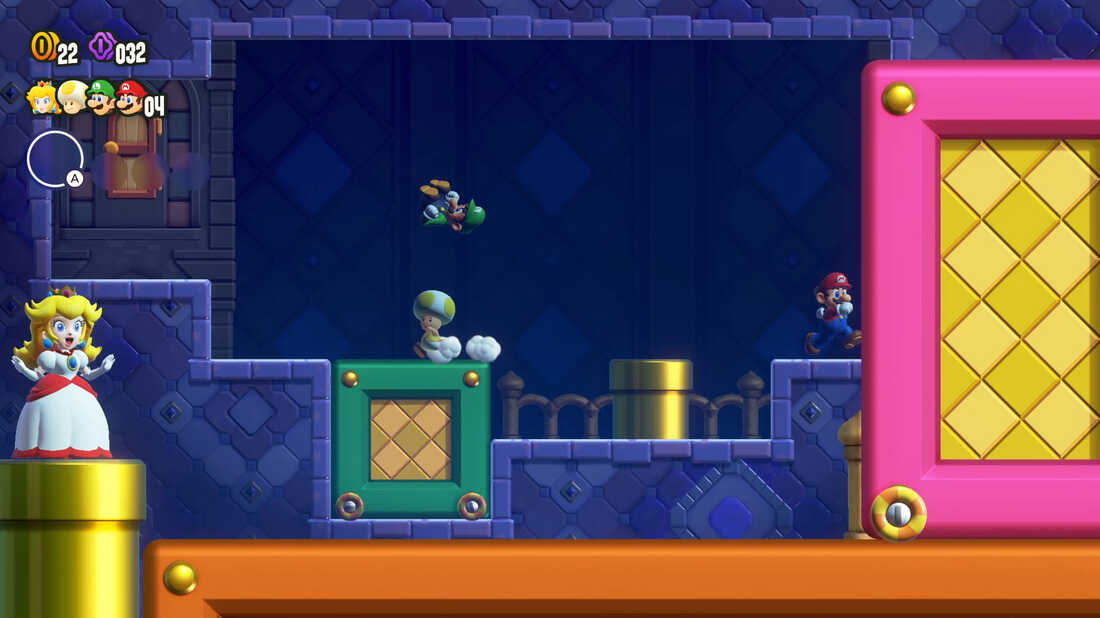
Mario and a Talking Flower contemplate the Wonder Flower that will soon rock their world.
Nintendo
Nintendo
Super Mario Bros. Wonder commits to the bit.
You’ll be running a side-scrolling Mario level, only to have the familiar 2D format break into a fever dream when you touch a titular Wonder Flower. Green warp pipes might grow eyes and start wiggling around. Or you’ll suddenly transform into a spiky boulder, flattening everything in your path. It gets weirder.
Tired of jumping from left to right? Treat yourself to a frantic vertical race as you’re transformed into a balloon, flapping your little arms and ricocheting off everything around you. Those Goombas you crushed? Congratulations — you’re one of them now; good luck avoiding the enemies that want to eat you!




How the tables have turned, Mario.
Nintendo
Nintendo
Mario has always contained multitudes — and that’s never been more true than in the past decade, after Super Mario Maker and its sequel empowered fans to make millions of their own levels: songs composed by hitting blocks in time to an automated mechanism; recreations of other video games, from The Legend of Zelda to Metal Gear Solid; stages so sadistic that less than one percent of players have cleared them.
So rather than try to top the near-infinite 2D Mario designs already available, Designers Takashi Tezuka and Shiro Mouri literally broke the rules. Think you know how Mario works? Think again.
Cross-pollination
3D Mario games have ventured far from the Mushroom Kingdom — they’ve gone to tropical islands, to outer space, to a Bowser Kaiju arena. Wonder, by contrast, is the first 2D Mario game to fully depart the classic setting for the neighboring Flower Kingdom.
Instead of opening with Bowser capturing a Princess, the game begins with a Wonder Flower transforming him into a talking, flying castle after he storms the home of the caterpillar Prince Florian. Florian then joins Mario and the gang to restore the Flower Kingdom by collecting hidden Wonder Seeds strewn across seven main worlds, while Castle Bowser floats menacingly above the center of the map.




Castle Bowser looms over the map, his minions sowing chaos across the Flower Kingdom.
Nintendo
Nintendo
You can usually get each level’s first Seed through the typical method: run to the end and jump on the flagpole. But standard levels also conceal a Seed you can only get by finding a Wonder Flower and playing through the lunacy it unleashes.
Green thumbs
You can easily beat levels without ever finding Wonder Flowers hidden under snow drifts, lurking in blocks, or guarded by baddies. But the game provides tools to assist with the hunt.
The first, Talking Flowers, are exactly what they sound like. They’ll point out curiosities as you pass them, crack jokes, or scream for their lives. I eventually found their obvious hints and breathless compliments grating, but you can turn them off, or, as Director Shiro Mouri has recommended, change the language they speak to one of the many available in the settings. I still read their speech-bubbles in English, but I appreciated the novelty that a Japanese or French voice provided (you could even learn some new words this way!).
Secondly, you can also equip a game-altering Badge, uncovered through special challenges or purchased with purple coins you’ll collect. Each confer useful advantages, from Peach’s signature floaty jump to a Wonder Seed proximity detector, and I often swapped between them to match my needs.




The Elephant power-up makes you massive enough to hit blocks from the side and allows you to spray from your trunk to water plants or damage enemies.
Nintendo
Nintendo
Thirdly, the game introduces new power-ups alongside the familiar Fire Flower and Power Mushroom. One lets you drill through the ground to reach secret areas. The Bubble power sounds harmless but decimates enemies at a distance, even through walls! But the Elephant power-up undoubtedly steals the show, since it doubles your size and lets you spray water from your trunk to unlock puzzles.
But the game’s multiplayer most transforms the search for Wonder Flowers — and Nintendo took a page from the unlikely source of Dark Souls and Elden Ring when designing them.
A Party, with Mario
While the game supports four local players, if you’re playing with up to two and connected to the internet, you’ll see other silhouetted characters running levels alongside you. Should you die, you’ll come back as a ghost with five seconds to touch one of these players (or a standee they can leave behind) to revive. I once cleared a late-game challenge by jumping to my death, resurrecting off of other players, jumping further ahead to another death, and thereby finally leapfrogging to safety. Elden Ring fans will recognize this asynchronous multiplayer — but it can only ever help you. You don’t have to fear invasion from a rogue Luigi!




Some warp pipes will carry you to the background of a level.
Nintendo
Nintendo
I must caution cooperative players, however. Despite removing the traditional time limit for each level, the pace of this new Mario game can be as breakneck as that of its longtime rival, Sonic the Hedgehog. I remember levels from 1990’s Super Mario World taking what felt like hours to beat — conversely, you can blitz through most of Wonder’s in minutes. While the game’s difficulty isn’t adjustable, powerful badges or playing as an invulnerable Yoshi or Nabbit can make the experience even more frictionless.
This speed isn’t a problem if you’re rolling solo, but if you’re playing with someone else you can quickly leave them behind, especially when wonder effects have you blasting through a level or careening through the sky.




One early wonder effect summons a stampede that carries you way past the normal end of the level.
Nintendo
Nintendo
Peak performance
Super Mario Bros. Wonder, ultimately, feels like a flex — proof that Nintendo can still innovate with some of gaming’s oldest verbs: run and jump. It’s a pristine extravaganza designed to appeal to nostalgic players and newcomers who may have only encountered the franchise through this year’s blockbuster movie. Every frame bursts with charming detail. Enemies glare at you as they approach, then look up in dismay the moment before you stomp on them. Mario will reach out to catch his hat after squeezing through a warp pipe. Untold hours of animation and programming talent went into delivering spectacles that parade by in seconds, leaving you dazzled in their wake.
Put simply, Super Mario Bros. Wonder shows off in the best of ways. It’s a game not only about exploration and discovery, but also about sitting back and enjoying the ride.
This post was originally published on this site be sure to check out more of their content.








